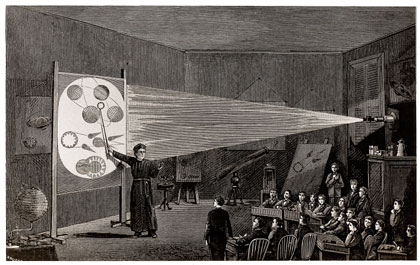It used a light source (which was either a candle or an oil lamp) to project a translucent image through a lens onto a flat surface, including a wall meaning it can be projected to entertain masses. It is simple for us, but was quite a big technological step forward in 1650.
It's main purpose was to entertain and mystify audiences of it's time, which it certainly achieved, it's audience had seen nothing like it, it was magical and revolutionary. It opened the doors to a new form of entertainment that wasn't going to the theatre, playing ball games, or painting. A form of moving image that would revolutionise theatre and art.
There were no further developments till the 19th Century with the Thaumatrope by Sir John Herschel.
This played with our persistence of vision, by placing two different images on the different sides of the same piece of card and spinning it rapidly with a piece of string through the middle, it creates the illusion that they are infact on the same piece of card. Therefore meaning you can create the illusion of something being inside something else for example a bird in a cage. This became a toy and form of entertainment for children and adults, who enjoyed being mystified by such optical illusion.
Closely following in 1831 was the Phenakistoscope, created by Joseph Plateau and Simon von Stampher. Which could be considered as the first attempt at animation, bringing drawings to life. playing with the persistence of vision aspect similarly to the Thaumatrope, to create the illusion of motion.
The viewer observes the animation in a
mirror by looking through the slots as the disc spins.
Film making duo the Brothers Lynch created a music video for the Carly Paradis song "The Hope of a Favourable Outcome", using GIFs of original Phenakistoscope's from the victorian era. It is mesmerizing whilst also remaining grotesque in their 19th Century aesthetic. The relentless beat of the song along with the seemingly endless tunnel of Phenakistoscope's, almost sends you into a trance.
I find it overall quite disturbing, the spiral effect along with the grotesque illustrations. I also find it weird how we consider illustrations from that time period so awful to look at, like they were born reflective of the dark and dingy streets of victorian Britain.
3 years later the Zoetrope was invented by William Horner, similar to a Phenakistoscope but with a cylinder instead of a disc, with vertical slots inside. They are printed on cards and placed inside and viewed through slots when rotated. In the 19th Century, Zoetropes were yet again used as a form of entertainment, to give the illusion of life to drawings.
Nowadays, Zoetropes are not as such a strong form of entertainment, now we have more wider mediums of entertainment. Now we use it to intrigue and to be unique, using techniques from the past. Also to pay tribute to such mediums that paved the path to the animation mediums we have today.
An example of this is seen within Comodos christmas Zoetropes for TVE;
Here Comodo pays tribute, yet also uses an appropriate medium to reflect the traditional aspect of christmas, to zoetropes. The hand-made, hand-crafted feel is really reflective of the christmas spirit, with cards and craft-markets which are rife throughout the festive season. Zoetropes as a medium of animation, have a very magical aura about them, deriving from how our victorian ancestors viewed them as they had no other forms of creating the illusion of life from moving image.
A more modern day concept of zoetropes is present within these 3D printed ones;
This is a great example of combining modern day processes and traditional methods to create something truly beautiful and unique. The fact it is a Zoetrope adds gravitas too and makes it 10x more amazing than if it was just created on some 3D software program.
In 1868 we saw the birth of flipbooks, one of the first examples of sequential imagery. A book with a set of images printed on one side that when flipped creates the illusion of motion, working on the same principle as the Zoetrope and Phenakistoscope but with layering up paper in sequence and flipping to see the image come to life.
A medium which also hasn't yet died out. As we observe these beautiful Japanese Flip-books by Mou Hitotsu no Kenkyujo;
Mou Hitotsu no Kenkyujo has transformed our old ideology of flipbooks, they aren't just a traditional medium of animation anymore, they are a magical medium of storytelling that you can unleash with your thumb, and takes you on a visual journey.
It is also brilliant to see Disney pay tribute to such a traditional method;
After becoming a worldwide successful animation company, to still pay tribute to the mediums that got them to where they are today is brilliant.


No comments:
Post a Comment